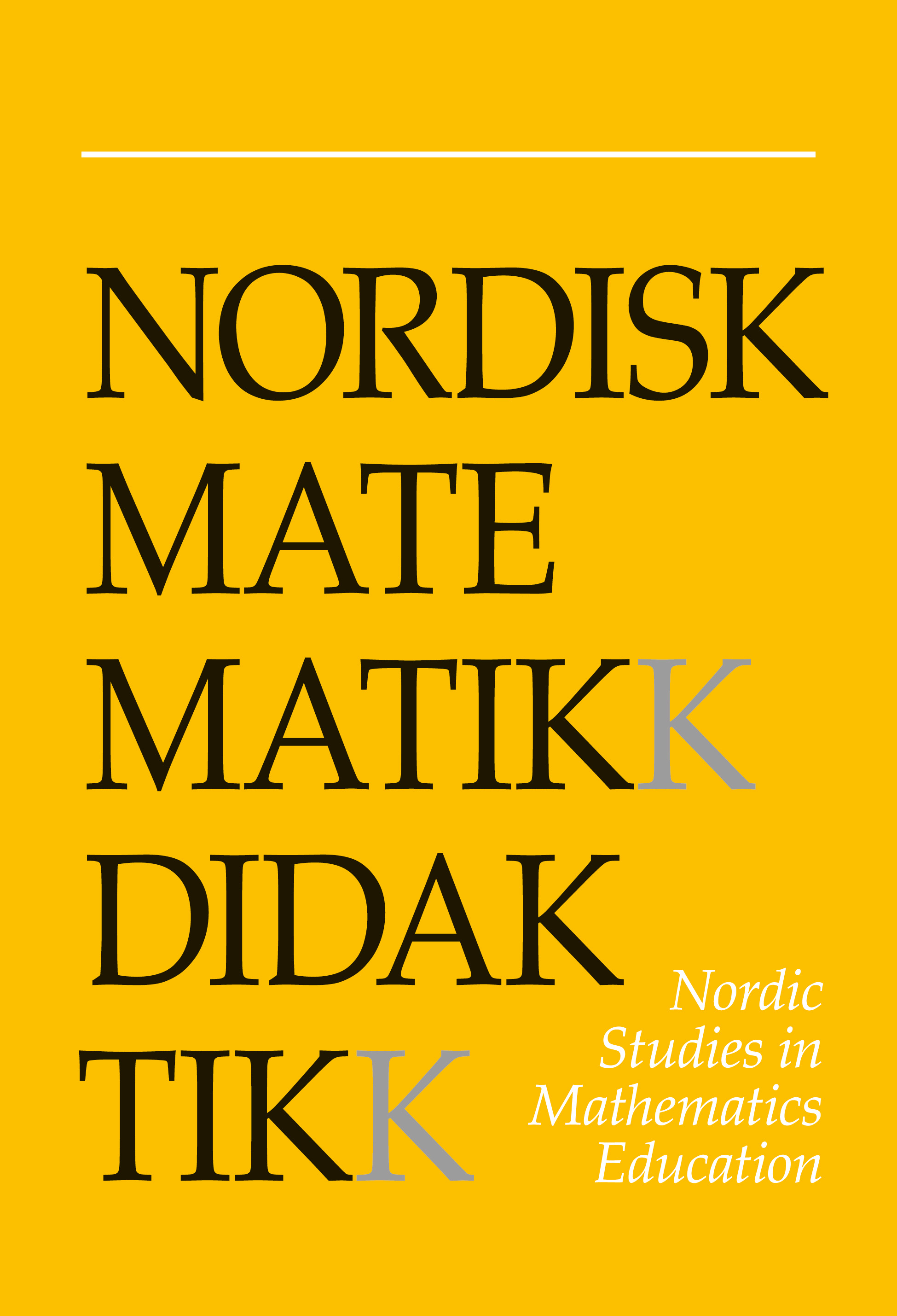Videreutdanningsstudenters undervisningskunnskap relatert til likhetstegnets betydning i algebra
DOI:
https://doi.org/10.7146/nomad.v27i2.149189Abstract
Vi ser på videreutdanningsstudentenes forståelse av algebraiske uttrykk og likhetstegnets betydning og hvilke didaktiske konsekvenser det kan få. Vi presenterer resultatene fra en algebraisk oppgave besvart av 82 norske lærere på videreutdanningskurs i matematikk, 5–10 (aldersgruppe 10–16 år). Vi har sett etter en forståelse av lærernes egne matematiske kunnskap, deres analyse av elevens løsning og tilbakemeldingen de ville gitt eleven. En tematisk analyse av lærernes skriftlige arbeid viste at lærerne sjelden identifiserte misoppfatning om likhetstegnet som et hinder for å løse en oppgave. Resultatene av denne studien kan forhåpentligvis fungere som et framstøt til å forbedre videreutdanning for matematikklærere i algebra.
References
Asquith, P., Stephens, A. C., Knuth, E. J. & Alibali, M. W. (2007). Middle school mathematics teachers' knowledge of students' understanding of core algebraic concepts: equal sign and variable. Mathematical Thinking and Learning, 9 (3), 249-271. https://doi.org/10.1080/10986060701360910
Attorps, I. (2003). Teachers' images of the "equation" concept. European Research in Mathematics Education, 3, 1-8.
Attorps, I. & Tossavainen, T. (2009). Is there always truth in equation? In C. Winsløw (ed.), Nordic Research in Mathematics Education. Proceedings from NORMA08 in Copenhagen (pp. 143-150). Sense. https://doi.org/10.1163/9789087907839_021
Ball, D. L., Thames, M. H. & Phelps, G. (2008). Content knowledge for teaching: What makes it special? Journal of Teacher Education, 59 (5), 389-407. https://doi.org/10.1177/0022487108324554
Black, P. & Wiliam, D. (2009). Developing the theory of formative assessment. Educational Assessment, Evaluation, and Accountability, 21 (1), 5-31. https://doi.org/10.1007/s11092-008-9068-5
Braun, V. & Clarke, V. (2006). Using thematic analysis in psychology. Qualitative Research in Psychology, 3 (2), 77-101. https://doi.org/10.1191/1478088706qp063oa
Bush, S. B. & Karp, K. S. (2013). Prerequisite algebra skills and associated misconceptions of middle grade students: a review. The Journal of Mathematical Behavior, 32 (3), 613-632. https://doi.org/10.1016/j.jmathb.2013.07.002
Cankoy, O. (2010). Mathematics teachers' topic-specific pedagogical content knowledge in the context of teaching a0, 0! and a ÷ 0. Educational Sciences: Theory & Practice, 10, 749-769.
Even, R. (1993). Subject-matter knowledge and pedagogical content knowledge: prospective secondary teachers and the function concept. Journal for Research in Mathematics Education, 24, 94-116. https://doi.org/10.2307/749215
Falkner, K. P., Levi, L. & Carpenter, T. P. (1999). Children's understanding of equality: a foundation for algebra. Teaching Children Mathematics, 6 (4), 232-236. https://doi.org/10.5951/TCM.6.4.0232
Fauskanger, J. & Mosvold, R. (2015). En metodisk studie av innholdsanalyse - med analyser av matematikklæreres undervisningskunnskap som eksempel. Nordic Studies in Mathematics Education, 20 (2), 79-96.
Jakobsen, A. Ribeiro, M. & Mellone, M. (2014). Norwegian prospective teachers' MKT when interpreting pupils' productions on a fraction task. Nordic Studies in Mathematics Education, 19 (3-4), 135-150.
Jenset, I. S., Canrinus, E. T., Klette, K. & Hammerness, K. (2018). Opportunities to analyse pupils' learning within coursework on campus: a remaining challenge in teacher education. European Journal of Teacher Education, 41 (3), 360-376. https://doi.org/10.1080/02619768.2018.1448783
Johannessen, L. E. F., Rafoss, T. W. & Rasmussen, E. B. (2018). Hvordan bruke teori? Nyttige verktøy i kvalitativ analyse. Universitetsforlaget.
Jones, I. & Pratt, D. (2012). A substituting meaning for the equals sign in arithmetic notating tasks. Journal for Research in Mathematics Education, 43 (1), 2-33. http://www.nctm.org/publications/article.aspx?id=31742 https://doi.org/10.5951/jresematheduc.43.1.0002
Kieran, C. (2004). The core of algebra: reflections on its main activities. I K. Stacey, H. Chick & M. Kendal (Red.), The future of the teaching and learning of algebra: the 12th ICMI study (s. 21-33). Kluwer Academic. https://doi.org/10.1007/1-4020-8131-6_2
Kilhamn, C. (2014). When does a variable vary? Identifying mathematical content knowledge for teaching variables. Nordic Studies in Mathematics Education, 19 (3-4), 83-100.
Kilhamn, C. & Röj-Lindberg, A.-S. (2019). Algebra teachers' questions and quandaries - Swedish and Finnish algebra teachers discussing practice. Nordic Studies in Mathematics Education, 24 (3-4), 153-171.
Klette, K. (2020). Hva vet vi om god undervisning? Rapport fra klasseromsforskningen. I R. J. Krumsvik & R. Säljö (Red.), Praktisk- pedagogisk utdanning - en antologi (2. utg., s. 183-214). Fagbokforlaget.
Kleve, B. (2007). Mathematics teachers' interpretation of the curriculum reform, L97, in Norway (Upuplisert ph.d.-avhandling). Høgskolen i Agder.
Knuth, E. J., Stephens, A. C., McNeil, N. M. & Alibali, M. W. (2006). Does understanding the equal sign matter? Evidence from solving equations. Journal for Research in Mathematics Education, 36 (4), 297-312.
Kongelf, T. R. (2015). Introduksjon av algebra i matematikkbøker for ungdomstrinnet i Norge. Nordic Studies in Mathematics Education, 20 (3-4), 83-109.
Mosvold, R. (2017). Studier av undervisningskunnskap i matematikk: internasjonale trender og nordiske bidrag. Nordic Studies in Mathematics Education, 22 (2), 51-69.
Nordenbo, S. E., Søgaard Larsen, M., Tiftikci, N., Wendt, R. E. & Østergaard, S. (2008). Lærerkompetanser og elevers læring i førskole og skole. Et systematisk review utført for Kunnskapsdepartementet, Oslo. Dansk Clearinghouse for Uddannelsesforskning, Aarhus Universitet. http://edu.au.dk/forskning/danskclearinghouseforuddannelsesforskning/udgivelser/laererkompetencerogeleverslaeringifoerskoleogskole/
Pimm, D. (1995). Symbols and meanings in school mathematics. Routledge.
Prediger, S. (2010). How to develop mathematics-for-teaching and for understanding: the case of meanings of the equal sign. Journal of Mathematics Teacher Education, 13 (1), 73-93. https://doi.org/10.1007/s10857-009-9119-y
Tall, D. & Thomas, M. (1991). Encouraging versatile thinking in algebra using the computer. Educational Studies in Mathematics, 22 (2), 125-147. https://doi.org/10.1007/BF00555720
Tchoshanov, M., Cruz, M. D., Huereca, K., Shakirova, K., Shakirova, L. & Ibragimova, E. N. (2017). Examination of lower secondary mathematics teachers' content knowledge and its connection to students' performance. International Journal of Science and Mathematics Education, 15 (4), 683-702. https://doi.org/10.1007/s10763-015-9703-9
Tirosh, D., Even, R. & Robinson, N. (1998). Simplifying algebraic expressions: teacher awareness and teaching approaches. Educational studies in mathematics, 35 (1), 51-64. https://doi.org/10.1023/A:1003011913153
Valenta, A. & Enge, O. (2015). Profesjonskunnskap for matematikk- lærerutdannere. Bedre Skole, 4, 74-78.
Vermeulen, C & Meyer, B. (2017) The equal sign: teachers' knowledge and students' misconceptions. African Journal of Research in Mathematics, Science and Technology Education, 21 (2), 136-147. https://doi.org/10.1080/18117295.2017.1321343
Downloads
Published
How to Cite
Issue
Section
License

This work is licensed under a Creative Commons Attribution-NonCommercial-ShareAlike 4.0 International License.



